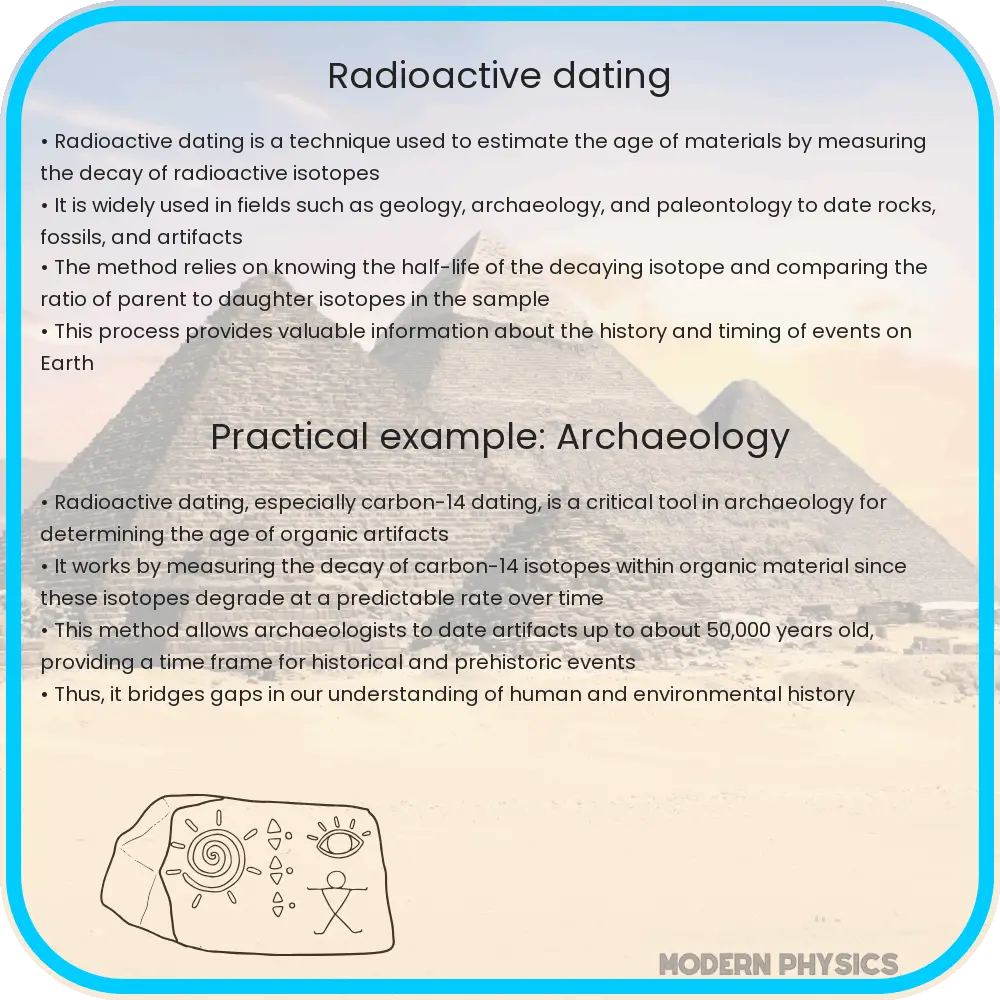Learn about radioactive dating, a technique used to determine the age of materials based on radioactive decay and isotopes’ half-lives.

Understanding Radioactive Dating: Principles and Techniques
Radioactive dating, also known as radiometric dating, is a method used by scientists to determine the age of materials such as rocks, minerals, and archaeological artifacts. This technique hinges on the understanding of radioactive decay, where unstable atoms lose energy by emitting radiation in the form of particles or electromagnetic waves.
Principles of Radioactive Decay
The core principle behind radioactive dating is the predictable decay of certain radioactive isotopes over time. Radioactive isotopes, or radioisotopes, are variants of elements that have an unstable combination of neutrons and protons in their nucleus. Over time, these isotopes decay into stable isotopes by shedding radioactive particles in a process that follows a predictable rate known as a half-life—the time it takes for half of the radioactive isotope in a sample to decay.
The half-life of an isotope varies from seconds to billions of years, depending on the isotope. For instance, the half-life of Carbon-14, widely used in dating organic materials, is approximately 5730 years. This predictable decay allows scientists to calculate the age of materials by measuring the ratio of remaining radioactive isotope to its decay products.
Common Radioactive Dating Techniques
- Carbon-14 Dating: Also known as radiocarbon dating, this method measures the decay of carbon-14 within organic matter. It is effective for dating once-living materials up to about 50,000 years old. Carbon-14 is continually formed in the atmosphere through the interaction of cosmic rays with atmospheric nitrogen, and it is absorbed by living organisms throughout their lives. After an organism dies, it no longer absorbs carbon-14, and the isotope begins to decay at a known rate.
- Uranium-Lead Dating: This method is typically used to date rocks older than 1 million years. It involves calculating the age of a rock sample by measuring the ratio of uranium-238 to lead-206 or uranium-235 to lead-207, both of which are decay products of uranium isotopes.
- Potassium-Argon Dating: Used to date volcanic materials and some types of metamorphic rocks. It is based on the decay of potassium-40 to argon-40. Since argon is a gas that escapes from molten rock, this technique measures the accumulation of argon within a mineral since the rock cooled and solidified.
Each of these methods relies on a few key assumptions. First, the rate of decay of the radioactive isotope is known and constant. Second, there was no daughter isotope present at the beginning, or the initial amount can be accounted for. Lastly, the material being tested has not been contaminated with additional parent or daughter isotopes since its formation.
By using these techniques, scientists can effectively unravel the age of materials and thereby unlock important data about geological periods or the timing of past events. The process involves not just the direct application of the half-life principle, but also an understanding of the surrounding geological or archaeological context to ensure accurate readings.
Limitations and Challenges
Despite the effectiveness of radioactive dating, several limitations and challenges exist. One significant hurdle is the need for precise laboratory techniques. Precise measurements of the radioisotope concentrations are crucial for correct date estimates; any error in measurement can lead to incorrect conclusions about the sample’s age.
Another issue is the assumption that decay rates are constant. While this is generally a safe assumption, external factors such as extreme pressures, temperatures, and chemical environments can potentially influence decay rates. This is a topic of ongoing research and debate among scientists.
Additionally, contamination by newer materials can lead to an incorrect reading. For example, if new uranium enters a rock sample, it can artificially elevate the amount of uranium-238 or uranium-235, leading to an inaccurately young age being recorded.
Future Directions
In response to these challenges, researchers continuously seek to refine techniques and develop new methods to ensure more reliable and accurate dating. Advances in detector technology and more precise laboratory instruments are key areas of focus. Additionally, interdisciplinary approaches combining radioisotopic methods with other dating techniques, such as luminescence dating, are proving helpful in cross-verifying the results obtained through radioactive dating alone.
The application of machine learning and artificial intelligence in radiometric dating is also emerging as a promising field. These technologies can help process large datasets more quickly and accurately, potentially overcoming some of the human error factors inherent in the current methodologies.
Conclusion
Radioactive dating remains a cornerstone technique in the fields of geology, archaeology, and other sciences that deal with past events and formations. The principles of radioactive decay and the various dating methods based on them provide a fascinating glimpse into the timeline of the natural world and human civilization. While there are challenges and limitations to this approach, ongoing scientific development promises to enhance its accuracy and applicability. With continued advancements, radioactive dating will remain an invaluable tool for uncovering the secrets of our planet’s and our ancestors’ pasts.
